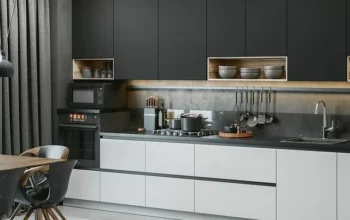From Hearth to Smart: How Kitchens Have Evolved Over the Years
As time passed, the concept of a modern and well-designed kitchen has changed drastically. Aesthetics blended in with functionality, and the cozy appeal was replaced with chic and minimalism.
Modern kitchen designs have changed a lot from what they used to be a few decades ago, incorporating elements that were once considered unusual.
Nowadays, with the rapid advancement of technology, kitchens have significantly improved in overall efficiency and effectiveness. Considering the design element alone, modern kitchens prioritize space and ease of use.
As far as tech goes, kitchens today can also be referred to as smart kitchens, as they include a variety of technology elements that aim to enhance your overall kitchen experience.
Today we’re focusing on exploring the fundamental differences between traditional and modern kitchens, covering elements like technological integration, use of space, storage solutions, and more. Moreover, we’ll shine a light on the importance of professional guidance throughout your kitchen transformation process and highlight the benefits associated with doing so.
Working With Professionals
Before we explore the main differences between traditional and modern kitchens, it’s essential to highlight the importance of working with professionals in your kitchen remodeling. Getting expert guidance ensures a smoother process, making informed choices for a successful kitchen transformation.
Collaborating with an experienced crew ensures that you benefit from their expertise, making informed decisions and avoiding common pitfalls in the remodeling process. This is where working with professionals offering home remodeling services in Austin comes in.
They enable you to get the most for your buck while having continuous help and assistance through the entire process. Professionals are extremely knowledgeable about popular design choices, premium material options, and projecting what works best for your space.
They work closely with you to ensure that the end product meets your needs and requirements to the fullest and are determined to complete the work in the most perfect way possible. In addition, they’re also well aware of local laws and building regulations and have the necessary tools and experience to complete the work seamlessly and in no time.
How The Modern Kitchen Was Formed
Traditional kitchens were mainly focused on cooking and serving food. Modern kitchens today are more so focused on entertainment and making the kitchen a cozy spot for socializing in the home. The shift reflects our changing lifestyle preferences and the evolving role of the kitchen as a central hub for gatherings.
Design-wise, changes can be seen mainly in the optimization of space, the inclusion of technology, as well as layout plans. The list below highlights several key elements in the kitchen that have undergone significant changes in the past few decades.
Layout Plan
Traditional kitchens were generally secluded from the rest of the home, having a space completely designated to them. This is because, in the past, kitchens were mainly viewed as functional spaces. Nowadays, modern kitchens are blended in with the rest of the home in what we now know as an open-concept layout, favoring both cooking and entertainment simultaneously.
Inclusion Of Technology
Traditional kitchens generally included common appliances such as the fridge, stove, and optionally a freezer. Such appliances weren’t necessarily from the latest state of the art technology and served the sole purpose of storing and preparing food. Modern kitchens on the other hand include a variety of technology such as touch controls, remote controlling, and even smart home integration systems. This all adds to the kitchen experience, improving efficiency and ease of use.
Storage Space
Kitchens today benefit from a variety of storage options such as pull-out shelves, deep drawers, and customized built-in organizers. This is all due to the evolution of kitchen storage designs, aiming to preserve the clean look of the kitchen while offering a great storage solution.
In contrast, older kitchens provided simple storage like shelves and cabinets for kitchen items. Back then, kitchen designs prioritized functionality for cooking, often leading to pantries being located elsewhere in the home due to less emphasis on storage.
Kitchen Materials
Traditional kitchens usually included materials that favored functionality over aesthetics such as hardwood and linoleum. The main purpose was to establish a sense of practicality rather than decorations. Nowadays, kitchen designs include materials that aim to elevate the overall design of the kitchen like granite, quartz, and sleek, increasing its aesthetic appeal and appearance.
The Use Of Space
Traditional kitchens were primarily workspaces, and entertaining guests usually happened in separate dining or living areas. The modern kitchen has evolved into a multifunctional space, seamlessly blending the tasks of cooking, dining, and socializing, with the incorporation of islands featuring seating, trendy breakfast bars, and open layouts that foster an inviting ambiance for both culinary activities and entertaining occasions.
Key Takeaways
In conclusion, the transition from traditional to modern kitchens signifies a shift in design philosophy, emphasizing a delicate balance between efficiency and aesthetics. Modern kitchens, with their integration of technology, thoughtful space optimization, and inventive storage solutions, mark substantial advancements in culinary spaces.
Stressing the importance of professional guidance underscores not only seamless execution but also the potential to create personalized and efficient kitchen spaces that cater to individual needs.
This evolution signifies not just a change in design elements but a profound transformation in the very essence of the kitchen, elevating it into a versatile and inviting hub for various activities beyond mere meal preparation. It becomes a central space for socializing, working, and enjoying the daily rituals of home life.




